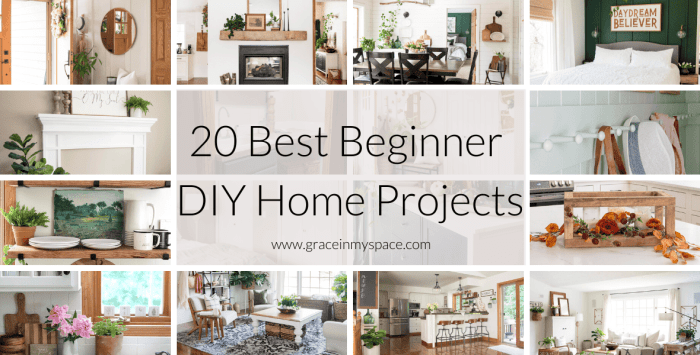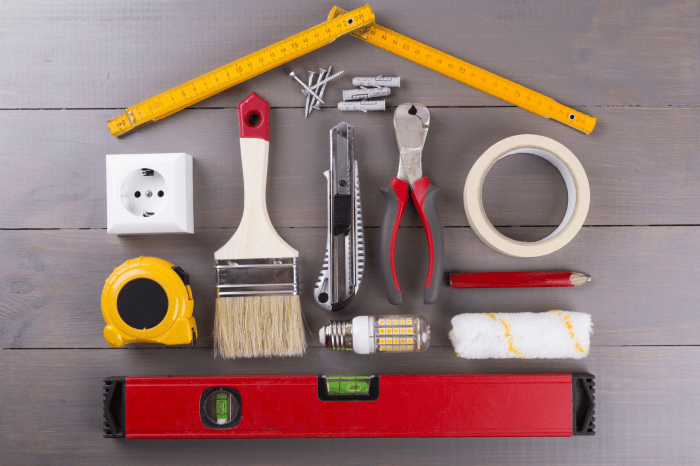DIY Home Improvement is all the rage, offering a mix of savings, satisfaction, and creativity for those looking to spruce up their living spaces. From easy projects to essential tools, get ready to dive into the world of home improvement like never before.
Whether you’re a seasoned DIY pro or just starting out, there’s something for everyone in this guide to elevate your home with style and flair.
Benefits of DIY Home Improvement

When it comes to DIY home improvement projects, there are several advantages that come with taking on tasks yourself. From saving money to the sense of accomplishment, DIY projects can be incredibly rewarding.
Saving Money
- By doing the work yourself, you can avoid labor costs associated with hiring professionals.
- You have the flexibility to shop around for materials and find the best deals, ultimately saving money on the overall project.
- DIY projects allow you to work within your budget and make cost-effective choices throughout the process.
Sense of Accomplishment
- Completing a DIY project can bring a great sense of pride and satisfaction, knowing that you accomplished something on your own.
- You have the opportunity to learn new skills and gain valuable experience that can be applied to future projects.
- The personal touch and customization that come with DIY projects can make your home feel truly unique and reflect your style.
Popular DIY Home Improvement Projects
When it comes to home improvement, there are several projects that homeowners can easily tackle on their own. From painting a room to installing a backsplash, these DIY projects can not only enhance the look of your home but also save you money in the process.
Painting a Room
Painting a room is a great way to freshen up the look of your space without breaking the bank. Here are some detailed steps to follow:
- Start by prepping the room – remove furniture, cover floors and tape off trim.
- Choose your paint color and finish.
- Prime the walls if needed.
- Start painting from the top down, using a roller for large areas and a brush for corners and edges.
- Allow the paint to dry completely before applying a second coat if necessary.
- Remove tape and touch up any areas as needed.
Installing a Backsplash
Adding a backsplash to your kitchen or bathroom can instantly elevate the look of the space. Here’s how you can install a backsplash on your own:
- Measure the area where you want to install the backsplash.
- Choose your backsplash material – whether it’s tile, peel-and-stick, or something else.
- Prepare the surface by cleaning and ensuring it is smooth.
- Apply adhesive to the backsplash material and press it onto the wall in your desired pattern.
- Allow the adhesive to dry and then grout the tiles if necessary.
- Finish by sealing the grout to protect your backsplash.
Changing Light Fixtures
If you’re just starting out with DIY home improvement projects, changing light fixtures is a simple yet impactful task to tackle. Here are some tips for beginners:
- Turn off the power to the fixture at the breaker box.
- Remove the old light fixture by unscrewing it from the ceiling.
- Disconnect the wires and remove the fixture.
- Install the new fixture following the manufacturer’s instructions.
- Connect the wires, secure the fixture, and turn the power back on to test the new light.
Essential Tools for DIY Home Improvement

When it comes to tackling home improvement projects on your own, having the right tools is essential. Whether you’re a seasoned DIY enthusiast or just starting out, having a well-equipped toolbox can make all the difference in the success of your projects.
Power Tools for Various Projects
Power tools can significantly speed up your DIY projects and make them more efficient. Here are some must-have power tools for different types of projects:
- Cordless Drill: Perfect for drilling holes and driving screws in various materials.
- Jigsaw: Ideal for cutting curves and intricate shapes in wood and other materials.
- Circular Saw: Great for making straight cuts in lumber and plywood.
- Orbital Sander: Essential for smoothing out rough surfaces before painting or finishing.
Safety Equipment
When working on DIY projects, safety should always be a top priority. Make sure to use the following safety equipment to protect yourself:
- Goggles: Protect your eyes from dust, debris, and flying particles.
- Gloves: Keep your hands safe from sharp edges, splinters, and other hazards.
- Masks: Prevent inhaling harmful dust, fumes, and particles while working with paints, chemicals, or cutting materials.
Budget-Friendly DIY Home Improvement Ideas
When it comes to sprucing up your living space without breaking the bank, there are plenty of budget-friendly DIY home improvement ideas to consider. From upcycling old items to finding affordable materials, these creative solutions can help transform your home on a tight budget.
Upcycling and Repurposing
One great way to save money on home improvement projects is to upcycle or repurpose materials. Instead of tossing out old furniture or decor, consider giving them a new life with a fresh coat of paint or a creative twist. You can turn old wooden pallets into a stylish coffee table, or transform mason jars into trendy light fixtures. The possibilities are endless when it comes to repurposing items for unique DIY projects.
Finding Affordable Materials, DIY Home Improvement
Another key aspect of budget-friendly home improvement is finding affordable materials and supplies. Look for discounts at local hardware stores, check out thrift shops for hidden gems, or even ask friends and family if they have any leftover materials you can use. By being resourceful and thinking outside the box, you can save a significant amount of money on your DIY projects.
Eco-Friendly DIY Home Improvement Solutions
When it comes to home improvement projects, incorporating eco-friendly solutions is not only beneficial for the environment but can also help you save money in the long run. By making simple changes to your home, you can reduce energy consumption and minimize your carbon footprint.
Using Renewable Energy Sources
One of the best ways to make your home more eco-friendly is by utilizing renewable energy sources. Installing solar panels on your roof can help reduce your reliance on traditional energy sources and lower your electricity bills. Additionally, you can consider using wind turbines or geothermal heat pumps to further enhance your home’s energy efficiency.
Upcycling and Repurposing Materials
Instead of buying new materials for your home improvement projects, consider upcycling or repurposing items to give them a new life. For example, you can use old pallets to create furniture or use reclaimed wood for flooring and wall accents. Not only does this reduce waste, but it also adds a unique touch to your home decor.
Water Conservation Strategies
Implementing water conservation strategies can also make your home more eco-friendly. Installing low-flow faucets and showerheads, fixing leaks promptly, and collecting rainwater for outdoor use are simple ways to reduce water consumption. Additionally, xeriscaping your yard with drought-resistant plants can help conserve water and create a sustainable landscape.






